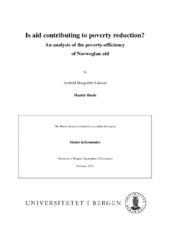Is aid contributing to poverty reduction? An analysis of the poverty-efficiency of Norwegian aid
Master thesis
Permanent lenke
https://hdl.handle.net/1956/6667Utgivelsesdato
2013-02-01Metadata
Vis full innførselSamlinger
- Department of Economics [289]
Sammendrag
This master thesis aims at assessing the poverty- efficiency of the current Norwegian aid allocation. Is Norwegian aid allocated in a way that has the maximum impact on poverty reduction? I use panel regression and a model developed by Collier & Dollar (2002) to construct a poverty- efficient allocation of aid across countries. This is how aid would be allocated if the sole purpose of donors was to maximize poverty reduction. I thereafter compare the optimal allocation to the current allocation of aid, and in particular to the Norwegian allocation, and I find large discrepancies between them. This can partly be ascribed to a large number of recipient countries. In the poverty-efficient allocation only 32 countries are found to be eligible for aid receipts. Concentrating aid to fewer recipients would increase the poverty-efficiency of the current allocation. I also find that the current Norwegian allocation of aid is considerably less in line with the poverty-efficient allocation than that of the average donor, the rank correlations between them are 0.42 and 0.63, respectively. I believe that the recent integration of environmental and foreign policy with aid is partly responsible for the results. Brazil is today the largest recipient of Norwegian aid, and the share of the aid budget pertaining to least developed countries is declining. There appears to be a trade-off between allocating aid for poverty reduction and playing a leading role in the areas of forest preservation and conflict prevention, which are increasingly prioritized sectors in the Norwegian aid budget. Had considerations of future poverty reduction been taken into account in the model, Norwegian aid might have been evaluated as more poverty-efficient than is the case in this analysis. Estimations and calculations are made using StataSE 11 and the poverty-efficient allocation is constructed in Excel 2007.
Beskrivelse
Revised version: Spelling errors corrected
